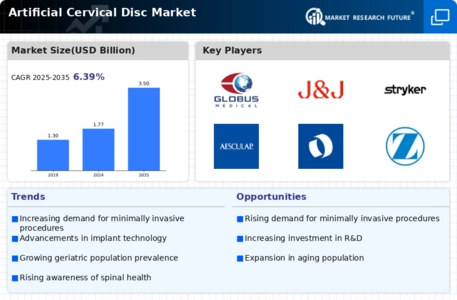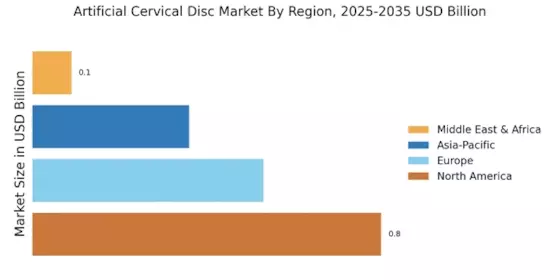Increasing Healthcare Expenditure
Rising healthcare expenditure across various regions is contributing to the growth of the Artificial Cervical Disc Market. As countries invest more in healthcare infrastructure and services, there is a corresponding increase in the availability of advanced medical technologies, including artificial cervical discs. This trend is particularly evident in developed nations, where healthcare budgets are expanding to accommodate innovative treatment options. Furthermore, as patients become more aware of their treatment choices, they are more likely to opt for advanced solutions like artificial discs, which can offer better outcomes compared to traditional methods. Consequently, the Artificial Cervical Disc Market is poised for growth as healthcare systems continue to evolve and prioritize advanced surgical interventions.
Rising Awareness and Patient Education
The growing awareness and education regarding cervical spine health and treatment options are driving the Artificial Cervical Disc Market. Patients are increasingly informed about their conditions and the potential benefits of artificial cervical discs, leading to higher demand for these products. Educational initiatives by healthcare providers and organizations are playing a crucial role in disseminating information about cervical disorders and available treatments. As patients become more proactive in seeking solutions, the market for artificial cervical discs is likely to expand. This trend suggests that as awareness increases, so too will the number of patients opting for surgical interventions, thereby positively impacting the growth trajectory of the Artificial Cervical Disc Market.
Rising Incidence of Cervical Disorders
The increasing prevalence of cervical disorders, such as herniated discs and degenerative disc disease, is a primary driver of the Artificial Cervical Disc Market. As the population ages, the incidence of these conditions appears to rise, leading to a greater demand for effective treatment options. According to recent estimates, cervical spine disorders affect millions of individuals worldwide, prompting healthcare providers to seek innovative solutions. The Artificial Cervical Disc Market is likely to benefit from this trend, as patients and physicians increasingly prefer artificial discs over traditional fusion surgeries. This shift is driven by the desire for improved mobility and reduced recovery times, which artificial discs can potentially offer. Consequently, the market is expected to expand as more patients seek surgical interventions for cervical spine issues.
Technological Innovations in Disc Design
Technological advancements in the design and materials used for artificial cervical discs are significantly influencing the Artificial Cervical Disc Market. Innovations such as the development of bio-compatible materials and improved engineering techniques have led to the creation of discs that mimic the natural motion of the cervical spine. These advancements not only enhance the performance of artificial discs but also improve patient outcomes. For instance, recent studies indicate that newer designs may lead to lower rates of complications and longer-lasting results. As a result, healthcare providers are increasingly adopting these advanced solutions, which is likely to drive market growth. The Artificial Cervical Disc Market is thus positioned to expand as manufacturers continue to innovate and improve their product offerings.
Growing Preference for Minimally Invasive Procedures
The shift towards minimally invasive surgical techniques is a notable trend impacting the Artificial Cervical Disc Market. Patients and surgeons alike are increasingly favoring procedures that minimize tissue damage and reduce recovery times. Artificial cervical disc surgeries, which can often be performed using minimally invasive techniques, align well with this preference. Data suggests that minimally invasive surgeries can lead to shorter hospital stays and quicker return to daily activities, making them an attractive option for patients. As awareness of these benefits grows, the demand for artificial cervical discs is likely to increase. This trend indicates a potential for market expansion as more healthcare facilities adopt these techniques and patients seek out less invasive treatment options.


















Leave a Comment